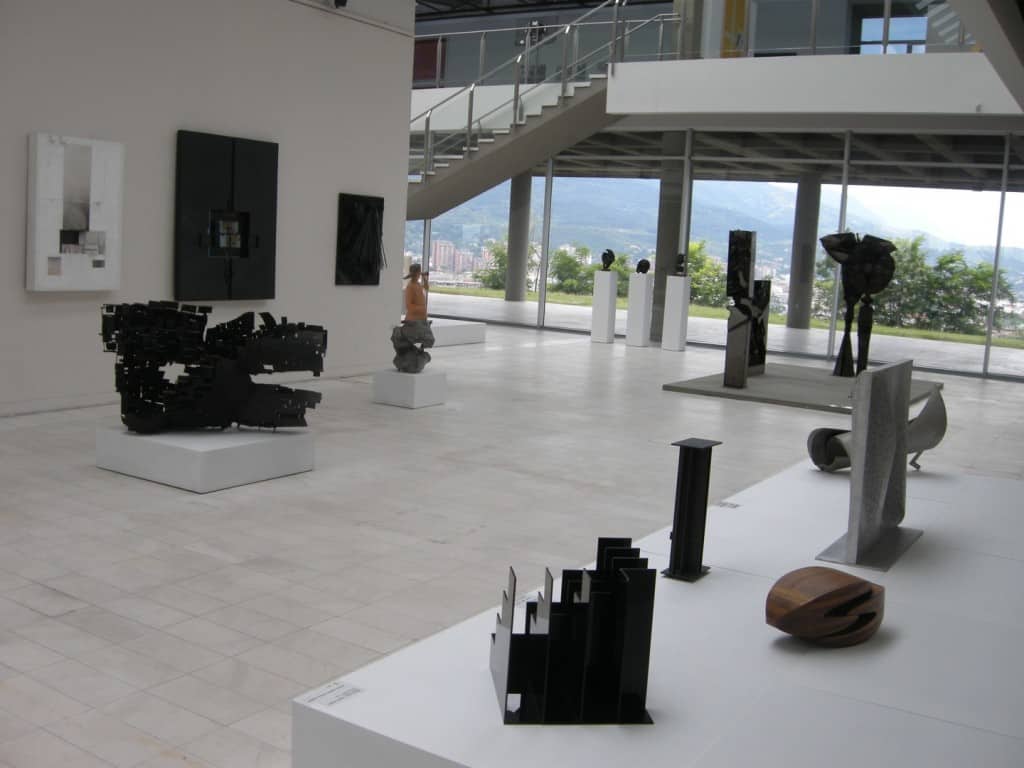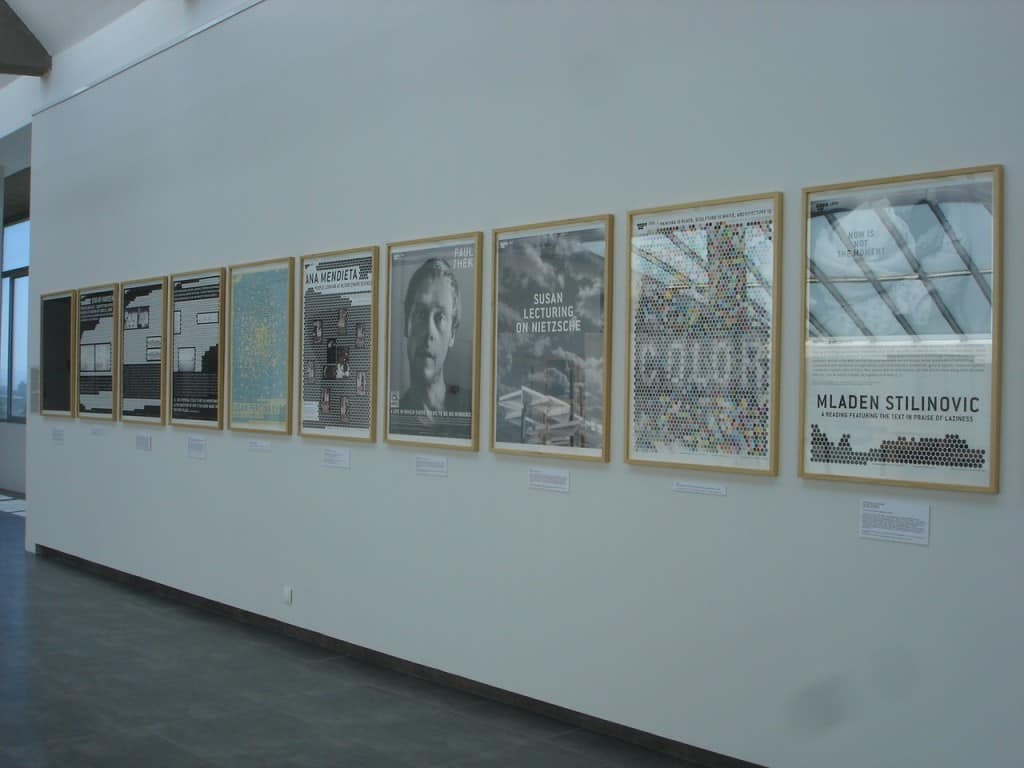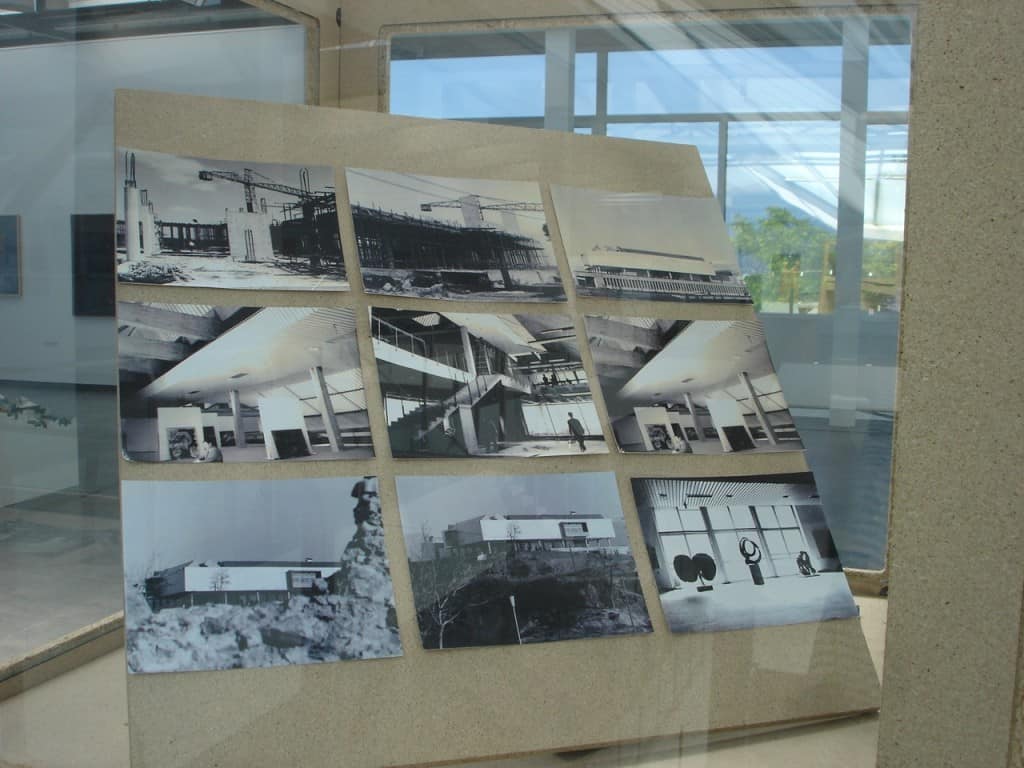Dobromila Blaszczyk: How did your collaboration with the Polish Embassy in Skopje come about and how did you find out about the Polish art collection at the Museum of Contemporary Art in Skopje?
Magdalena Ziółkowska: Muzeum Sztuki in Łódź (The Museum of Art) received an official invitation to work together with the Ministry of Culture and National Heritage in Warsaw. They were told that the Museum of Contemporary Art in Skopje holds a vast collection of works produced by Polish artists during the 1960s and 1970s, which had yet to be examined by local curators, researchers and conservators. Upon the invitation, the Ministry began looking for an institution that could undertake the task of verifying and scientifically analysing the collection. This is how the Muzeum Sztuki in Łódź got involved. The reason we collaborated was clear – our collection in Łódź includes the works of almost all the artists who donated their pieces to the museum in Skopje. But the collection also functions as priceless comparative material. I was very familiar with the history of the Museum of Contemporary Art in Skopje. My PhD thesis focused on comparing the treatment of time in two projects taken from the same year, 1966 – the theoretical proposal for the Museum of Current Art by Jerzy Ludwiński, and the Process and Art project by Oscar Hansen (the co-authors included Svein Hatløy, Barbara Cybulska and Lars Fasting, with the help of Jerzy Dowgiałło). Hansen’s Museum of Contemporary Art proposed an entirely different understanding of history and time, following the notion that within the modern world, which forever looks towards the future, there is no space for linear time and narration. Hansen’s constantly shifting temporal system of wall-less platforms and elevations, each emerging by surprise, contests the accumulation of historical events, facts and objects. With every project the museum would be created “from scratch”, from “square one”, without any regard for the past, deconstructing the notion of continuity in the historical art canon. History would not be a factual report of past events – this was not what Hansen had in mind.

During the works, from left to right: Blagoja Varoshanec, the assisting curator, Bogumiła Terzyjska – conservator from Muzeum Sztuki in Łódź, Milan Dzingo – photographer, photo M. Ziółkowska
D.B.: What was your task in Skopje?
M.Z.: We were invited to take a look at all the works and identify them alongside existing listings of exhibitions. In addition, we were asked to determine their individual condition and provide our knowledge and opinion on pieces which need to be conserved and cared for, if they are to be exhibited in the future. It was also our duty to isolate exceptionally valuable works by the name and prestige of the artist. None of us knew what to expect to see at the museum, apart from distinguishing a few names which appeared in the museum’s former exhibition catalogue, including Nowosielski, Bogusz and Stażewski. Stażewski’s Relief was exhibited at the museum’s most recent exhibition. The employees of the museum were not entirely aware of the background nor context of the individual artists and their pieces, nor the subtle changes and shifting discourse of the collection.
D.B.: Apart from Relief by Henryk Stażewski, I understand that the rest of the works were stored in a warehouse?
M.Z.: Yes, selected works were occasionally exhibited at formal presentations of the collection, such as one of the prints by Barbara Kwaśniewska, a graduate of the Painting Department at the Jan Matejko Academy of Fine Arts in Cracow, who emigrated to Paris in the late 1950s. Naturally, there is an inventory of the works themselves, which features recorded information on every object in the museum’s collection, as well as the story of its acquisition. However available works for public viewing are a rarity.
D.B.: The works donated by other countries have already been analysed and catalogued, and vastly exhibited at the museum. Is this task of researching the works of Polish artists an attempt at curating a similar exhibition?
M.Z.: Yes, and I believe that is what the ambassador’s wife Mrs Kinga Nettmann-Multanowska had in mind when she saw the catalogue of works by German, Serbian and Dutch artists comprised succinctly into a comprehensive publication.

Ewa Maria Łunkiewicz-Rogoyska, “Kompozycja czerwona” (Red Composition), photo M. Ziółkowska
D.B.: Have you seen the whole of the Polish collection? How would you describe it?
M.Z.: The biggest group of works constitutes 111 prints executed in various techniques ranging from zincography, lithography, woodcut, monotype, as well as drawings on paper. Many of them are the work of many celebrated artists connected for instance, with the International Print Triennial. However also featured are the works of lecturers from the Warsaw and Cracow Academy of Fine Arts. These include Góra Kalwarii by Jan Cybis, Czesław Rzepiński’s still life, Rowerzysta V by Mieczysław Wejman, Powrót z majówki by Konrad Srzednicki, Postać siedząca II by Marian Malina, Głowy by Olga Peczenko, Zbiorowisko by Jan Tarasin, as well as Leszek Sobocki’s self-portraits. Most of these pieces were created between 1965–1967, and have been to the Museum by the artists themselves – the back panel of some of the works feature hand-written dedications. However, one must bear in mind that these are one-off donations. Only several artists have donated more than one work, such as Jan Berdyszak, Zygmunt Kotlarczyk, Danuta Leszczyńska-Kluza, and Franciszek Bunsch. In the sculpture collection, which considerably constitutes one of the smaller categories, there are a range of interesting pieces such as a bronze cast by Karol Tchorek titled Głowa, similar to the one at the artist’s workshop on 36 Smolna Street in Warsaw. Oszczepnik by Władysław Frycz, as well as Bronisław Chromy’s Haghia Sophia and Owca are also worthy of mention. Amongst the works on canvas, several pieces stand out including Jadwiga Maziarska’s Cricot for its exceptionally thick texture, and Ewa Maria Łunkiewicz-Rogoyska’s smaller-sized work on wood, Kompozycja czerwona. A matron of the inter-war and post-war avant-garde circles, Łunkiewicz-Rogoyska is one of the oldest artists featured in the collection. Also included are Jerzy Nowosielski, Jan Cybis, Tadeusz Brzozowski, Alfred Lenica, Jerzy Krawczyk, Tadeusz Dominik, Andrzej Strumiłło, Rajmund Ziemski, and Adam Marczyński. Benon Liberski’s urban landscape painting Ludzie i domy was a huge surprise to us. A somewhat forgotten graduate of The Strzemiński Academy of Art Łódź, the artist was also a lecturer, who was very much immersed in Łódź’s artistic circle. His works Działoszyn (1965) and Chemostal (1966) hark back to the anxiety and fascination surrounding technological advancements of the era. Układ form alfa I by Jerzy Rosołowicz, Kompozycja z cyklu Rytmy by Marian Szpakowski, and Kompozycja 20159 by Marian Bogusz are further examples of pieces that adequately capture the post-war atmosphere between 1966-1967. There is also reference to the artist events, which took place over the two years in the pieces, including the Artists and Scientists Symposium in Puławy in August 1966, further spurring interest in the relationship between people, the environment, art and technology.
D.B.: You have gathered material in Skopje, and now you are in Łódź dealing with the cataloguing of the works. What will be the effect of this trip and the research?
M.Z.: Our presence and long-term contribution to the project largely depends on what the Polish Embassy in Skopje, the Ministry of Foreign Affairs and the Ministry of Culture and National Heritage decide. The most challenging part of the project is behind us; we have completed the list of exhibits and documented their condition. At the moment we are waiting for the final text on the Polish collection, which is to accompany the online and print versions of the catalogue. We have also taken part in producing a film documenting the entire project.

Pablo Picasso, “Portrait of a Woman”, photo M. Ziółkowska

Museum of Contemporary Art in Skopje, photo courtesy the Embassy of Poland in Skopje
D.B.: You’ve spent a lot of time with the employees of the museum and local artistic circles. What was their reaction on hearing that Polish art constitutes a considerable part of their museum’s collection? Could you say a few words about Skopje Museum’s full collection?
M.Z.: Our contact with the employees of the museum was pretty intense – our everyday duties of surveying the artwork, measuring and cataloguing it, were performed in the presence of the assistant curator, a photographer, and sometimes other curators. The international exhibition is presented across two floors. At the beginning of the section titled Solidarity – an Incomplete Project stands Alexander Calder’s mobile sculpture. The works are organised non-chronologically, divided in accordance to the technique that they were made in. There is particular emphasis on the idea of donation, and the history of how the collection came to be. The curatorial execution of the exposition was largely determined by the space of the building itself. The most valuable pieces of the collection are Pablo Picasso’s portrait of a woman, a series of drawings by Bernard Buffet, as well as the works of post war Yugoslavian artists such as Gabrijel Stupica, Stane Kregar, Otton Gliha. Sculptures and reliefs are presented in the “open” part of the building, which features windows on three walls, following the designer’s intention of the ground floor as a transparent space open to the environment – the city as it is seen from Kale hill and the neighbouring hills surrounding it. Due to maintenance problems surrounding climatic conditions, this space is used purely for temporary exhibitions and the execution of installations.
Magdalena Ziółkowska – PhD in Art History, curator, graduate of the Art History Institute at the Warsaw University, Graduate School of Social Research and Curatorial Training Programme in de appel arts centre in Amsterdam (2006/2007). In 2013 she earned a doctoral degree for her thesis on the concept of the Museum of Recent Art in Wrocław, and Polish museum studies in 1960s, as well as institutional reforms in Europe. In 2006–2010 she was a guest curator at Van Abbemuseum in Eindhoven, where she implemented projects such as Notes From the Future of Art. Selected Writings of Jerzy Ludwiński (2007) and Andrzej Wróblewski. To the Margin and Back (2010). She collaborated with the Museum of Art in Łódź between 2008–2014, and is the is the author of projects such as Art Always Has Its Consequences (2008–2010), Working Title: Archive (2008–2009), Sanja Iveković. Practice Makes the Master (2009), Eyes Looking for a Head to Inhabit (co-curator, 2011), Hüseyin Bahri Alptekin. Facts, Incidents, Accidents, Circumstances, Situations (co-curator, 2013–2014). Lately she has edited the Teoria Sztuki Zbigniewa Dłubaka anthology (Warsaw 2013) and co-curated the Only to melt, trustingly, without reproach exhibition (Škuc galerija, Lublana 2013–2014). Since 2012, she has been the co-founder and vice-president of the Andrzej Wróblewski Foundation, the co-curator of the Andrzej Wróblewski exhibition Constantly Looking Ahead (National Museum, Cracow 2012–2013) and the author of the bi-lingual monograph of the artist Avoiding Intermediary States. Andrzej Wróblewski (1927–1957). Since January 2015 the director of the Bunkier Sztuki Modern Art Gallery in Cracow.
All activities relating to the Collection of Polish Art in Skopje supports the Ministry of Foreign Affairs of the Republic of Poland and the Polish Ministry of Culture and National Heritage
Translated by Ewa Tomankiewicz

Museum of Contemporary Art in Skopje, photo courtesy the Embassy of Poland in Skopje

Hristina Ivanoska and Yane Calovski, “Oskar Hansen’s Museum of Modern Art”, Original posters, edition 10+2AP, 70 x 100 cm; courtesy of the artists and Zak Branicka, Berlin, photo M. Ziółkowska

Hristina Ivanoska and Yane Calovski, “2000 ‘s: FOR THE INDEPENDENT – based on true stories”, exhibiting the work “MOCA has goat ears” curated by Ivana Vaseva; detail of installation, photo M. Ziółkowska










